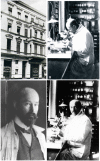Brodmann: a pioneer of human brain mapping-his impact on concepts of cortical organization
- PMID: 30358817
- PMCID: PMC6202576
- DOI: 10.1093/brain/awy273
Brodmann: a pioneer of human brain mapping-his impact on concepts of cortical organization
Abstract
On the 150th anniversary of Korbinian Brodmann’s birth, and the 100th anniversary of his death, Zilles celebrates his pioneering role in brain mapping. With the aid of hitherto unpublished documents and figures, he explains the concepts behind Brodmann’s cytoarchitectonic maps and considers their impact on current neuroimaging approaches.
Figures








References
-
- Amunts K, Zilles K. A multimodal analysis of structure and function in Broca’s region. In: Grodzinski Y, Amunts K, editors, Broca’s Region. New York, NY: Oxford University Press; 2006. p. 17–30.
-
- Amunts K, Zilles K. Architectonic mapping of the human brain beyond Brodmann. Neuron 2015; 88: 1086–107. - PubMed
-
- Barbas H. Pattern in the laminar origin of corticocortical connections. J Comp Neurol 1986; 1252: 415–22. - PubMed
-
- Barbas H. General cortical and special prefrontal connections: principles from structure to function. Annu Rev Neurosci 2015; 38: 269–89. - PubMed
-
- Bailey P, von Bonin G. The isocortex of man. Urbana, IL: University of Illinois Press; 1951.
Publication types
MeSH terms
Personal name as subject
- Actions

